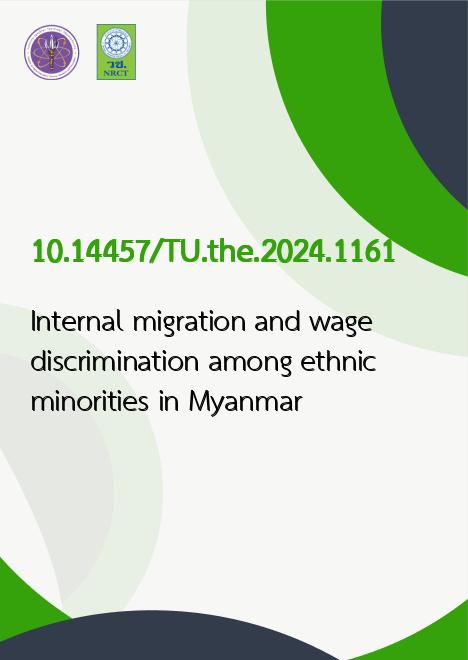
|
Internal migration and wage discrimination among ethnic minorities in Myanmar |
|---|---|
| รหัสดีโอไอ | |
| Title | Internal migration and wage discrimination among ethnic minorities in Myanmar |
| Creator | Lwin May May Aung |
| Contributor | Kiatanantha Lounkaew, Advisor |
| Publisher | Thammasat University |
| Publication Year | 2567 |
| Keyword | Ethnic wage discrimination, Internal migration, Oaxaca-Blinder decomposition, Rural-urban wage gap, Myanmar labor market, Structural discrimination, การเลือกปฏิบัติทางค่าจ้างตามเชื้อชาติ, การย้ายถิ่นฐานภายในประเทศ, การแยกองค์ประกอบของโออาซากา-ไบลเดอร์, ช่องว่างค่าจ้างระหว่างชนบทและเมือง, ตลาดแรงงานเมียนมาร์, การเลือกปฏิบัติเชิงโครงสร้าง |
| Abstract | This study investigates ethnic wage disparities in Myanmar, a country marked by deeply rooted ethnic diversity and a long history of structural inequality. Drawing on data from the 2017 Myanmar Living Conditions Survey and employing the Oaxaca–Blinder decomposition method, the analysis disaggregates wage differentials between the ethnic Bamar majority and minority groups including Kachin, Kayah, Karen, Chin, Mon, Rakhine, and Shan across national, regional, and generational cohorts (Generation X and above vs. Generations Y and Z). Findings reveal that Bamar workers enjoy a persistent wage advantage, particularly in urban and Bamar-majority regions. In contrast, ethnic minorities, despite having equal or even superior observable characteristics such as education or skills, consistently receive lower wage returns. This indicates the presence of systematic labor market discrimination. In ethnic-minority-dominant areas, however, wage gaps tend to be narrower or even reversed, suggesting the existence of localized structural privileges. To contextualize internal migration, the study incorporates the Human Capital Investment Model and the Harris–Todaro framework. Although ethnic minorities who migrate to urban centers gain limited improvements in digital access, they remain disadvantaged in literacy, numeracy, and mobile technology use. This challenges the assumption that urban migration automatically enhances human capital. Generational comparisons further show that younger ethnic minorities, despite being more educated and urbanized, face wider unexplained wage gaps. While older minorities experience relative wage advantages in sectors such as mining and construction, younger cohorts remain concentrated in low-paid occupations, even those with tertiary education. Proficiency in the Burmese language only marginally reduces the explained component of the wage gap and does not mitigate broader disadvantages. In several cases, language skills contribute negatively to the explained component especially among younger minorities, suggesting that linguistic assimilation fails to yield equitable labor market outcomes. Rather than being rewarded, language proficiency appears to reflect adaptation within a system that continues to undervalue ethnic minority labor. In conclusion, ethnic wage inequality in Myanmar cannot be fully explained by human capital differences. Instead, it stems from entrenched structural exclusion and institutional bias. Moreover, language proficiency alone is insufficient to overcome persistent labor market discrimination. These findings highlight the urgent need for targeted policy interventions to address ethnic prejudice, eliminate language-based barriers, and reform informal labor practices to promote equitable and inclusive economic development. |